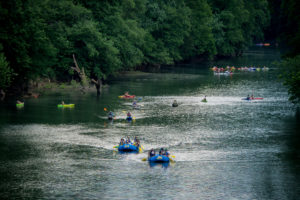We have much more to do and your continued support is needed now more than ever.
Affiliate of the Week: West Virginia Rivers

In honor of our 80th Anniversary celebration throughout 2016, the National Wildlife Federation is recognizing each of our Affiliate Partners in a special “Affiliate of the Week” blog series that showcases the dedicated conservation efforts taking place across the country each day. This week we celebrate our affiliate, West Virginia Rivers Coalition, and their commitment to wildlife.

WHO WE ARE
West Virginia Rivers was formed in 1989 by a group of paddlers, birders, and outdoor enthusiasts who were concerned about the degradation of the state’s mountain streams and the public lands surrounding them. Today, WV Rivers is the only statewide organization in West Virginia working on water policy and federal public lands advocacy. Throughout the years, the original founding groups have expanded to include people and businesses concerned about drinking water and public lands.
While others may know West Virginia as the Mountain State, to WV Rivers’ supporters, the state is also known as the Headwaters State. Located in the Monongahela National Forest are the headwaters of the Potomac and the rivers that feed the Ohio, which provide drinking water for millions of Americans. WV Rivers’ special focus is bringing together diverse coalitions who understand the connections between our public recreation lands and the waters on which we all rely.
The Monongahela National Forest is home to 90% of the state’s native trout streams and over a dozen threatened or endangered plants and animals. Through policy and advocacy at the state and federal levels, WV Rivers works to protect West Virginia’s rivers and streams from the headwaters to wherever they flow.

WHAT WE DO
WV Rivers policy and advocacy work is built on three pillars:
- Framing the public dialogue around water and wildlife habitat through extensive education, media outreach and social media;
- Policy research and advocacy through partnerships like the Water Policy Work Group and coalitions like the National Wildlife Federation’s Choose Clean Water Coalition (a Chesapeake Bay advocacy effort);
- Continued drive to expand and diversify grassroots support for public lands and clean water.

As the NWF state affiliate, WV Rivers champions public lands funding and policies like the Land and Water Conservation Fund (LWCF), public lands policy defense, and a campaign to designate the Birthplace of Rivers National Monument — their signature public lands effort.
To strengthen these efforts, in 2016, with help from NWF, WV Rivers deployed a digital advocacy platform that enables them to target state and federal legislators. Before June, this tool enabled them to generate over 4,600 letters to state legislators on water policy and over 1,500 letters to Congress and the President in support of LWCF, the Antiquities Act, and Birthplace of Rivers.
This year, WV Rivers also launched the Safe Water for West Virginia program, focusing on protecting drinking water supplies and helping to raise awareness that clean water starts with healthy headwaters.

Through a natural gas pipeline monitoring partnership with Trout Unlimited, they have trained 305 volunteer stream monitors who gather data about the impacts of fracking and proposed pipelines on habitat and drinking water.
Furthermore, WV Rivers’ efforts to protect wildlife habitat extend beyond public lands. In 2014, for instance, they promoted the survival of the rare diamond darter fish through a successful endangered species listing and critical habitat designation along the Elk River.
MAKING A NATIONAL IMPACT
At roughly 900,000 acres, the Monongahela National Forest is West Virginia’s most prominent landscape feature. WV Rivers leads an effort to protect 120,000 acres of this important area by creating the Birthplace of Rivers National Monument in the southern portion of the forest.
The Birthplace of Rivers is one of the wildest places in Appalachia, containing the largest federally designated wilderness area east of the Mississippi. There are over 150 miles of trails, excellent native brook trout streams, and the the least amount of light pollution in a 15 state region.

Ecologically, the area provides habitat for black bear, waterfowl, wild turkey, and other wildlife, in addition to serving as a foothold for threatened or endangered species. The Birthplace of Rivers’ springs and streams are also the beginning of much of the state’s drinking water supply.
The effort to protect this area has included continued advocacy with the WV Congressional delegations; DC fly-ins with local advocates, sportsmen, and business owners; and extensive grassroots advocacy statewide. Similar to other public lands initiatives, this campaign has included a dose of fun outside! In spring 2016, WV Rivers supported two young adventurers on a sojourn from the headwaters of the Elk River in the proposed monument to the Kanawha River and the state capitol. The trip, known as “Elkspedition,” captured public and media imagination.
Through media spots and public events, including a flotilla of 60 boats on the final day, the 173-mile Elkspedition helped highlight the connections among the integrity of public lands and the downstream rivers that are enjoyed for recreation and relied on for drinking water.

GET INVOLVED
You can help speak out for public lands conservation — no matter where you live!
By joining WV Rivers’ email list, you can get involved in their policy work and public lands protection. You can also learn about volunteer opportunities and hear about some of the fun events: outings, the popular film festival, and events on public lands.
Donations to WV Rivers support advocacy efforts on behalf of public lands, including Birthplace of Rivers, water policy initiatives, and hard-to-fund programs like policy research and communications and outreach.
CONNECT WITH WV RIVERS
Connect with WV Rivers to get their latest news and keep up with their conservation efforts through Facebook, Twitter, or by visiting their website. Members also receive the Headwaters newsletter twice each year.






















